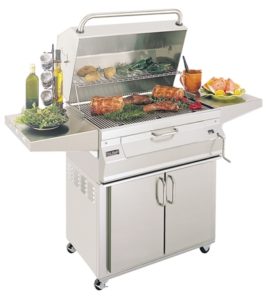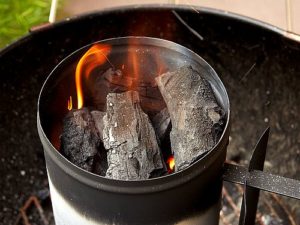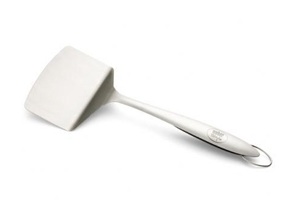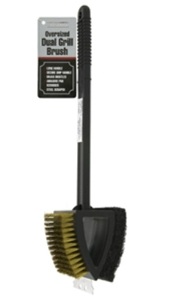Grilling 101
In Texas, we grill and we barbecue. The two are distinctly separate and not synonymous acts. Barbecue is the topic for another day.
 Grilling is the act of cooking over a source of focused heat, most likely outside, and for one reason or another, the domain of men… mostly. Whether you are grilling over a campfire, or over the flames of a Ferrari-like summer kitchen grill, the act of grilling is basically the same. The beauty is in the details. Let’s consider the basics. You have a grill over some source of intense heat, and a series of tools by which you deliver whatever it is you are cooking to and from the grill. Beyond this are the details.
Grilling is the act of cooking over a source of focused heat, most likely outside, and for one reason or another, the domain of men… mostly. Whether you are grilling over a campfire, or over the flames of a Ferrari-like summer kitchen grill, the act of grilling is basically the same. The beauty is in the details. Let’s consider the basics. You have a grill over some source of intense heat, and a series of tools by which you deliver whatever it is you are cooking to and from the grill. Beyond this are the details.
The Grill
Your grill is probably going to be steel, stainless perhaps, and maybe expanded steel that has a distinctive diamond pattern. Copper’s impractical, aluminum is dangerous, and cast iron probably has holes stuff will fall through. Your grill should have a fire area, elevated from the bottom of the grill container, thus allowing for air to feed the fire, and easier cleanup when you remove the resulting ashes, which must be done after grilling to result in better fires and a longer lasting grill. In better grills, the fire area may be lowered and raised to promote better use of the fire, fine-tuning of temperature areas, and s`more cooking for later.
Regardless of the fire source beneath the grill, the griller (you) should know the temperature of the grill surface in order properly to cook. There will probably (ideally) be zones of differing temperature. If you can put your hand a couple of inches above the grill and, without burning yourself, hold it there for only 2 to 4 seconds, we may say the grill is a high heat, meaning above 450 degrees. If you can hold your hand there from 5 to 7 seconds, it is a medium heat, meaning above 350 degrees. If you can hold your hand there 8 to 10 seconds, you have a low heat, which is around 250 to 250 degrees. If you can rest you hand on the grill, you probably forgot to light the fire. You must get to know your grill (they are all different) and where the hotter and relatively cooler spots are, in order to know where to place what grilling items.
The Fire

This brings up the most basic question – coals or gas? Cooking with briquette, charcoal, or wood allows one to impart a fire-based flavor to the grilled items. Wood, soaked in water for hours, will burn more slowly, and will smoke, imparting nuance that simple gas does not. Many people use gas, propane and natural, because it is easier: one twist of a dial and the flames are on. Using flavoring wood is more complicated. Coals take time to light and prepare, between 10 and 30 minutes. One method is to pour the charcoal into a sheet metal chimney over a wadded up sheet of newspaper. This starts the coals from the bottom up: ideal for cooking. Some may insist on using some fire starting agent sprayed over the coals, though good quality coals may not require this. The chimney is a great, effective, and economical way of starting coals. It will last years. Alternately, one may pile coals over an electric element which, plugged in, will start the coals, again, from the bottom up. One may choose, simply, to soak the coals in fire starter and fling a match on the pile, or use a hot air driven starter, though these take the coals longer to thoroughly light. In any case, after the coals have flamed, have turned grey with ash, and are glowing as a pile, the fire is ready.
If you have the ability and room, you would do well to spread the glowing coals in the grill such that they are not evenly spread, but piled more deeply on one side, creating a range of temperature areas on the grill. This will allow for a range of choices and staging areas in the grilling process.
Equipment

You must have a spatula, at least. A long fork and a pair of tongs are nice and allow you to finesse. You will likely need a mop (or brush) for spreading marinade or sauces. Realizing some hands are more sensitive than others, you may want to invest in a laser thermometer, which will tell you exactly how hot an area is, for precise grilling. A light is especially handy when, as so often happens, you grill at night away from better lighting. For fish and certain meats, you would do well to have a set of cedar planks on which to cook. For more fragile items and vegetables, a grilling basket is perfect, and allows you to control items that otherwise might roll around or off the grill. A set of bamboo skewers, soaked in water for at least a half hour, or better yet, kept soaked and frozen in the freezer, will allow you to kebab vegetable cubes. There are also baskets to grill corn on the cob, though one may want to grill those in the husk.
Cleaning Your Grill

The grill should be cleaned after each use with a wire brush or scraper. Before use, the grill should be oiled with some cooking oil, rubbed on with a brush or mop. This reduces sticking and eases flipping or moving whatever is being grilled. It also makes cleaning up when done grilling much easier.





